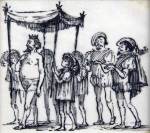Following the Nobel Prize in literature for the last few years I have noticed a discernible pattern. Barely a handful of  readers seem to know the author from before he got the award. Herta Muller is such a classic case. On the official site of the Nobel Prize a poll was put on, asking how many of the readers knew her work before the announcement of the award. The result was 11 percent! I dutifully bought one book – The Passport – of Muller and started reading.
readers seem to know the author from before he got the award. Herta Muller is such a classic case. On the official site of the Nobel Prize a poll was put on, asking how many of the readers knew her work before the announcement of the award. The result was 11 percent! I dutifully bought one book – The Passport – of Muller and started reading.
 readers seem to know the author from before he got the award. Herta Muller is such a classic case. On the official site of the Nobel Prize a poll was put on, asking how many of the readers knew her work before the announcement of the award. The result was 11 percent! I dutifully bought one book – The Passport – of Muller and started reading.
readers seem to know the author from before he got the award. Herta Muller is such a classic case. On the official site of the Nobel Prize a poll was put on, asking how many of the readers knew her work before the announcement of the award. The result was 11 percent! I dutifully bought one book – The Passport – of Muller and started reading. It is a surrealist novel about the life of a minority German people living in a border town of Rumania. Their only desire is to get a passport and migrate to Germany. All of their life is devoted in getting it, hence the name. Life under Communism has robbed them of their dignity and the protagonist sends his daughter to the officials in order to get the passport. The mother had also once worked as a prostitute in Russia.
It is a surrealist novel about the life of a minority German people living in a border town of Rumania. Their only desire is to get a passport and migrate to Germany. All of their life is devoted in getting it, hence the name. Life under Communism has robbed them of their dignity and the protagonist sends his daughter to the officials in order to get the passport. The mother had also once worked as a prostitute in Russia.The Passport is a very vague and indirect condemnation of Communism. Except for a couple of direct passages describing the atrocities of the Ceausescu regime, there are very few indicators about what the book is all about. Timeframe of the novel is also not clear. An approximate guess would be, somewhere in the middle of 70s and 80s. The tragedy of Communism is reduced to a bored indifference of attitudes.
The Passport is a grey blend of past and present, reality and dreams, history and art. The novel is divided into many short chapters, often not more than one or two pages; independent of context and of each other.
The narrative mode is simple present. It makes the narrative disjointed and staccato. The surrealist images permeate  the novel so thoroughly that after a few pages it becomes hard to follow her. We often find sentences like, ‘The Man is a black thread walking into the field.’ ‘The white closed car drove out of the village as slowly as a room.’ ‘A man is swimming in the water. He swims after his hands.’ They make for good surrealism but bad story telling.
the novel so thoroughly that after a few pages it becomes hard to follow her. We often find sentences like, ‘The Man is a black thread walking into the field.’ ‘The white closed car drove out of the village as slowly as a room.’ ‘A man is swimming in the water. He swims after his hands.’ They make for good surrealism but bad story telling.
 the novel so thoroughly that after a few pages it becomes hard to follow her. We often find sentences like, ‘The Man is a black thread walking into the field.’ ‘The white closed car drove out of the village as slowly as a room.’ ‘A man is swimming in the water. He swims after his hands.’ They make for good surrealism but bad story telling.
the novel so thoroughly that after a few pages it becomes hard to follow her. We often find sentences like, ‘The Man is a black thread walking into the field.’ ‘The white closed car drove out of the village as slowly as a room.’ ‘A man is swimming in the water. He swims after his hands.’ They make for good surrealism but bad story telling.The barbarity of Communism dehumanized its citizens and forced them to put material things above moral ethics. They developed an indifference towards everything happening around them. Anything new was an omen of evil. Change had to be bad. Things could not change for better in a Communist regime. All a citizen of a Communist state could do, was to try and preserve the status quo, ignoring everything else.
This indifference is vaguely shown in the Passport, but there is another level of indifference – that of Herta Muller’s own. She is as indifferent about her characters and story as they are about their life. The indifference goes to a deeper level. The brutalization of Communism numbed the human sensibilities of her characters. The phenomenon of post-modernism numbed Muller’s own sensibility.
A majority of modern authors, dramatists and poets are postmodernist. I have gone through a few of them in the past years – Harold Pinter, Italo Calvino, Jorge Luis Borges, Orhan Pamuk, J M Coetzee, Harumi Murakami etc. Except for a few works, I have generally not liked the works of postmodernism. No matter how hard I try I cannot understand the meaninglessness of their content and style.
This unconcern; this severe indifference cannot be natural. We do not write about things unimportant to us. The indifference is feigned. It is just a literary pose. A writer cannot be indifferent towards his subject. Otherwise he would not write at all.
The psychological suppression under the Communist regimes is brilliantly portrayed in the works of non-fiction. The Whisperers by Orlando Figes, Soviet Tragedy by Martin Malia provide brilliant insights into the psychology of the Soviet citizens in the Stalinist times. They make for good history as well as excellent literature. While Muller turned to postmodernism to describe her experiences under Communism, writers like Alexander Solzhenitsyn and Boris Pasternak kept it straight. I cannot help rereading their works over and over again, while I could hardly get through to the end of the hundred pages long The Passport. Instead of being indifferent towards their subject they are highly concerned about it. The tragedy is told in a beautiful and haunting language. Bleak subject does not call for bleak narration.
 Once, the function of literature was to depict life and all its colors in human aspect. Dickens, Austen, Tolstoy and Dostoyevsky told more about their people than did the contemporary historians and sociologists. This responsibility now falls upon non-fiction. Mainstream literature has run dry, both of facts and feelings and increasingly readers are finding it hard to find a reason to turn to a work of literature instead of watching a movie, reading a thriller or getting engrossed in a work of non-fiction.
Once, the function of literature was to depict life and all its colors in human aspect. Dickens, Austen, Tolstoy and Dostoyevsky told more about their people than did the contemporary historians and sociologists. This responsibility now falls upon non-fiction. Mainstream literature has run dry, both of facts and feelings and increasingly readers are finding it hard to find a reason to turn to a work of literature instead of watching a movie, reading a thriller or getting engrossed in a work of non-fiction.Literature, under the influence of postmodernism, has taken up a pose of feigned indifference and resolutely refuses to be direct and clear. It is considered taboo to say anything directly. Directness is not ‘literary’ enough. The greatness of an artist is measured by the weirdness of his art. All it depicts is confusion, absurdity and meaninglessness of everything in an equally confused, absurd and meaningless style.
The surrealist images of the Passport convey nothing. Surrealism, by definition, destroys reality. It grew out of Dadaism, which is cultural vandalism, crude and simple.[1] Surrealism’s founder Andre Breton asserted that surrealism is above all a revolutionary movement.[2] Its intent is to destroy, to destroy everything traditional and conventional, and just like the Bolshevik Revolution, it has destroyed more than it has created.
The art of late 18th and early 19th century was dominated by socialist ideas. The purpose was to make art subservient to the ideology. The ‘logic’ was that only the Revolution can set art ‘free’.[3] Though modernist and post-modernist factions fought bitterly, they all swallowed socialist principles in varying degrees. Every discipline was influenced. Bertolt Brecht, whose works are generally touted as the precursors of Theatre of the Absurd, was a convinced Marxist and his ‘distancing’ or ‘estrangement’ effect has shaped much of the modern drama.[4] James Joyce and Virginia Woolf changed the novel forever by their technique of ‘divergent chapters’. Surrealism and Dadaism influenced painting, sculpture and literature.
This is not to condemn surrealism as such. Writers like Kafka have put surrealism to great use. Art has no commitment to either surrealism or realism. An artist is free to employ whatever artistic technique he deems necessary. The objective is to convey the essence of the work of art in the most effective way. An ideal artist finds the golden mean between the familiar and the strange.[5] If realism serves the purpose it is good. If surrealism does, then it is good too. It just has to be meaningful. V S Ramachandran, the neuroscientist argues for ‘artistic universals’ in The Emerging Mind:
“Anyone today will tell you that art has nothing to do with realism. It is not about creating a replica of what’s out therein the world. I can take a realistic photograph of my pet cat and no one would give me a penny for it. In fact, art is not about realism at all – it’s the exact opposite. It involves deliberate hyperbole, exaggeration, even distortion, in order to create pleasing effects in the brain.
But obviously that can’t be the whole story. You can’t just take an image and randomly distort it and call it art. (Although in California, where I come from, many do!). The distortion has to be ‘lawful’. The question then becomes, what kinds of distortion are effective? What are the laws?”[6]
He then goes on to describe the ten principles. The point is that just because Science is definite, accurate and meaningful does not mean that art has to be completely vague and meaningless. Any randomly distorted piece cannot be called art.
Most of the post-modernist art is meaningless and it is considered inartistic and unfashionable to criticize it. If a piece of art does not appeal to you, it means that you are not sensible and sophisticated enough to understand it. It is not considered good to judge. Since modern art has progressed by breaking every tradition, the categories of good and bad are meaningless to it. And since there is no longer any sense of good and bad, there is no point in judging anymore. The sole criteria of judging art is its strangeness. It just has to be weird!
A few of my friends read The Passport after Muller got Nobel. Though I hardly found anything admirable in the book, they all felt obliged to praise it. I could not understand why? Perhaps they were intimidated by her Nobel reputation? Though hardly anyone comprehends the postmodernist writings, they seldom criticize it. Most of the times they heap praises on it, calling it high art. Academic circles are more vulnerable to this intellectual intimidation because their own reputations rest on praising the officially sanctioned writers, the canonical works. Every awarded book falls in this category. A professor has to praise it because if he does not then he will be considered unfit for guiding the students. A media person has to praise it because he needs to understand the voice of the masses! A writer of course has to praise it, since he does not want to commit the heresy of judging.
 The phenomenon of postmodernism reminds me of the beautiful story of Emperor’s New Clothes. The emperor strode naked and yet nobody dared to tell him so. They were afraid of him. They had reasons to lie. They feared losing their privileges by telling the truth. It took a child to have the courage to reveal the truth to the king; to recognize it for what it was… bogus. I just wish we all had a little more of the child in us…
The phenomenon of postmodernism reminds me of the beautiful story of Emperor’s New Clothes. The emperor strode naked and yet nobody dared to tell him so. They were afraid of him. They had reasons to lie. They feared losing their privileges by telling the truth. It took a child to have the courage to reveal the truth to the king; to recognize it for what it was… bogus. I just wish we all had a little more of the child in us…













0 komentar:
Posting Komentar